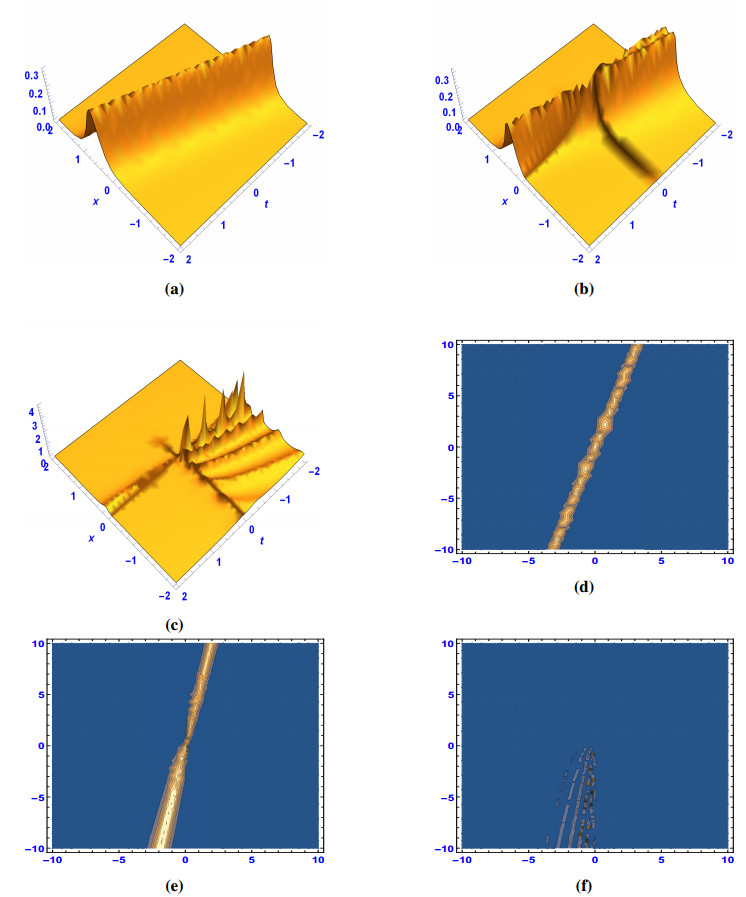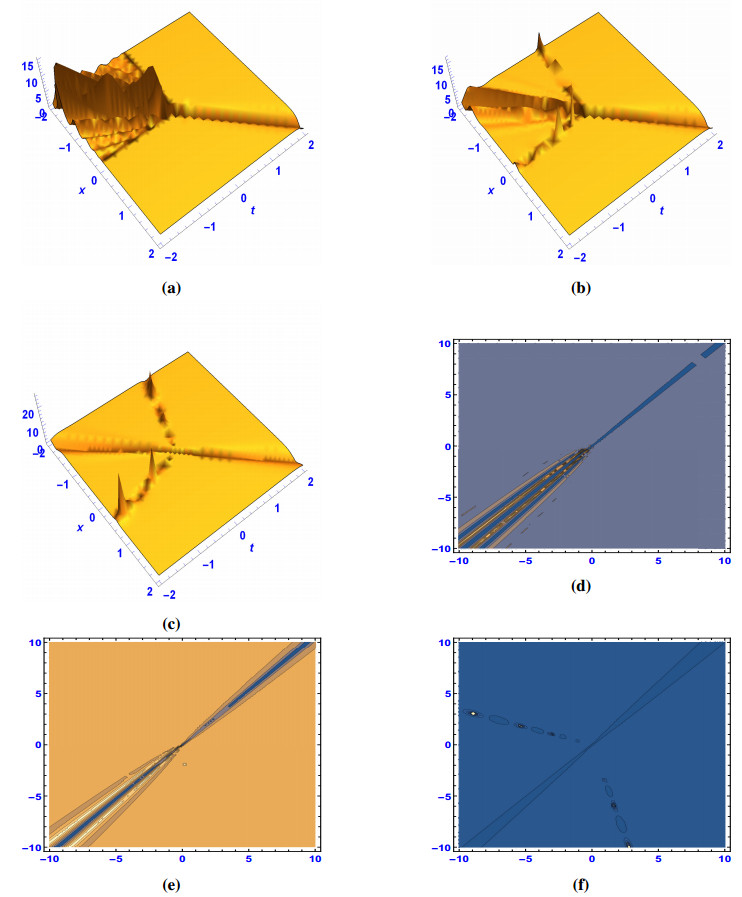1.
Introduction
A key practice in nonlinear physics has been the study of both the formation and interaction of localized waves, including plasma physics, fluid dynamics, Bose-Einstein condensates and photonics, over the last few decades. Among different types of nonlinaer localized waves, solitons are the most representative and ideal testbed to investigate nonlinear wave interactions due to their intrinsic particle-like properties during propagation [1,2]. The position and phase shift interaction-induced displacement is typically independent of the relative phases of the solitons in the envelope. The dynamics of collisions in the region of interaction, however, depend strongly on the relative levels. The wave magnitude then evolves at the central collision point from the sum of the amplitudes of the two solitons to their distinction, respectively. A wide range of theoretical theories, computational simulations and experimental observations have already been recorded for such interactions with solitons and their possible synchronization [3,4,5]. In general, nonlinear Evolution Equations (NLEEs) are used to model social processes and structures of natural phenomena. In various fields of science and engineering, nonlinear wave phenomena exist, including fluid mechanics, chemical dynamics, plasma physics, solid-state physics, nonlinear optics, and population models. In nonlinear science, the precise wave outcomes of NLEEs play a crucial role, since they give us a lot of insight into the physical characteristics of the problem and can provide more physical details to support additional applications. In recent years, people have been fascinated by the precise and numerical solutions of NLEEs since they are increasingly becoming more used in various scientific fields to explain complex nonlinear phenomena. Via differential equations, some real-world problems are converted into mathematical equations.
The quest for soliton outcomes has been of significant importance in the understanding of nonlinear phenomena in recent years. Soliton's theory has been strengthened in recent decades in order to explain the meaning of impossibility in ordinary and partial differential equations [6,7,8,9,10,11,12,13,14]. The nonlinear Schrödinger equation (NLSEs) has been studied in various equations to demonstrate Soliton propagating molecules in an optical fiber, which has a variety of physical applications especially in plasma physics and nonlinear optics. There are several variants of the NLSEs; these forms, such as Kaup-Newell, Chen-Lee-Liu, and Gerdjikov-Ivanov equations, are the recently determined forms. The equation Kaup-Newell [15] has various forms. The equations can be modified to each other by Guage transformation [16]. Transformations can not sustain the reduction in the dispersion issue [17,18,19,20]. Conditions and integrations are highly dynamic and cannot be precisely planned. They need impartial investigation, therefore. In order to overcome these categorized NLSEs, a large number of numerical and exact moving wave mathematical schemes have been identified [21,22,23,24,25,26,27,28,29,30,31,32,33,34,35,36,37,38,39,40,41,42,43].
In this paper we consider the Hamiltonian amplitude equation with the M-truncated order "μ" given by [44]
where σ±1 is the coefficient of the nonlinear term, δ<1 is the coefficients of the dispersionless term, ζ is a nonzero real number, and Dμ,ζM,∗χ represents the truncated M-fractional derivative of χ with respect to x and/or t. Non-linearity arises when the change of the output is not proportional to the change of the input. Dispersion means that waves of different wavelength propagate at different phase velocities. The phase velocity of a wave is the rate at which the wave propagates in some medium. This is the velocity at which the phase of any one frequency component of the wave travels. Studies have shown that when the dispersion effect and nonlinear effect of the medium reach a stable equilibrium, the pulse can maintain its shape and velocity in the form of solitons during the transmission process [45].
Equation (1.1) was introduced in [46]. The term χ(x,t) is the unknown complex envelope function of x and t. This equation governs certain instabilities of modulated wave trains; the addition of the term −δχxt overcomes the ill-posedness of the unstable NLSEs. The equation is apparently not integrable, but a Hamiltonian analogue of the Kuramoto–Sivashinsky equation, which arises in dissipative system.
2.
Applications
Here, we acquire the optical solitons of the Hamiltonian amplitude equation with M-truncated derivative by using the extended sinh-Gordon equation expansion method [47] and the and the extended rational sine-cosine/sinh-cosh methods [48].
Consider the following fractional wave transformation:
Plugging Eq (2.1) into (1.1), provides the following nonlinear ordinary differential equation
from the real part, and the constraint condition
from the imaginary part.
2.1. Application of the extended sinh-Gordon equation expansion method
Here, we present the application of the extended sinh-Gordon equation expansion method to (1.1).
Balancing the terms ϕ″ and ϕ3, we get n=1. With n=1, we have the following test functions [47]:
and
Plugging Eq (2.4) and its second derivative alongside θ′=sinh(θ) into Eq (2.2), provides an equation with hyperbolic functions power. We collect a set of algebraic equations by equating each summation of the coefficients of the hyperbolic functions of the same power to zero. We simplify the set of algebraic equations and secured the values of the parameters involved. To reach the solutions of Eq (1.1), we substitute the values of the parameters into any of Eqs (2.5) and (2.6).
Ⅰ: For
we reveal the combined dark-bright soliton
and the combined singular soliton
Ⅱ: For
we reveal the bright soliton
and the singular soliton
Ⅲ: For
we get the dark soliton
and the singular soliton
2.2. Application of the extended rational sine-cosine/sinh-cosh methods
Here, we present the application of the extended rational sine-cosine/sinh-cosh methods to (1.1).
Consider the following as the first test function to Eq (2.2):
Putting Eq (2.13) into Eq (2.2), provides a polynomial functions. Setting the coefficients of the powers of cos(ξ) gives a system of algebraic equations. Solving the set of algebraic equations provides the following set of values to the unknown coefficients:
Ⅰ: For
we reveal the singular periodic wave solution
Ⅱ: For
we reveal the singular periodic wave solution
Consider the following as the second test function to Eq (2.2):
Putting Eq (2.16) into Eq (2.2), provides a polynomial functions. Setting the coefficients of the powers of sin(ξ) gives a system of algebraic equations. Solving the set of algebraic equations provides the following set of values to the unknown coefficients:
Ⅰ: For
we reveal the singular periodic wave solution
Ⅱ: For
we reveal the singular periodic wave solution
Consider the following as the third test function to Eq (2.2):
Putting Eq (2.19) into Eq (2.2), provides a polynomial functions. Setting the coefficients of the powers of cosh(ξ) gives a system of algebraic equations. Solving the set of algebraic equations provides the following set of values to the unknown coefficients:
Ⅰ: For
we reveal the dark soliton
Ⅱ: For
we reveal the periodic wave solution
Consider the following as the fourth test function to Eq (2.2):
Putting Eq (2.22) into Eq (2.2), provides a polynomial functions. Setting the coefficients of the powers of sinh(ξ) gives a system of algebraic equations. Solving the set of algebraic equations provides the following set of values to the unknown coefficients:
Ⅰ: For
we reveal the singular soliton
Ⅱ: For
we reveal the periodic wave solution
3.
Physical interpretation
As it was presented in the preceding section, two analytical approaches were used in securing the optical solitons to the fractional Hamiltonian amplitude equation. To have a clear physical view to the features of the reported results in this study, numerical simulations are performed via the 3-dimensional and contour graphs by a careful choice of the parameters' values involved. The dynamics of the reported solutions is analyze based on the choice of the fractional values μ.
Figure 1 displays the shape of bright-soliton at μ=1. When μ=0.7, solution (2.9) maintains its dark-soliton shape with shork-shock, and changes to short-shock waves at μ=0.5. Figure 2 displays the shape of dark-soliton at μ=1. When μ=0.9, solution (2.11) maintains its bright-soliton shape with shork-shock, and changes to short-shock waves at μ=0.5. Figure 3 portrays the shock-periodic wave shape at three different fractional values of μ.
4.
Results and discussion
We investigated the Hamiltonian amplitude equation that governs certain instabilities of modulated wave trains. We have successfully reached some important wave solutions to this nonlinear model such as the dark, bright, combined dark-bright, singular solitons, periodic and singular periodic wave solutions. It is known that dark soliton describes the solitary waves with lower intensity than the background, bright soliton describes the solitary waves whose peak intensity is larger than the background and the singular soliton solutions is a solitary wave with discontinuous derivatives; examples of such solitary waves include compactions, which have finite (compact) support, and peakons, whose peaks have a discontinuous first derivative [49,50].
Moreover, results presented in this study have some important physical meaning, for instance, the hyperbolic sine arises in the gravitational potential of a cylinder and the calculation of the Roche limit, the hyperbolic cosine function is the shape of a hanging cable (the so-called CATENARY), the hyperbolic tangent arises in the calculation of magnetic moment and rapidity of special relativity, the hyperbolic secant arises in the profile of a laminar jet and the hyperbolic cotangent arises in the Langevin function for magnetic polarization [51].
5.
Conclusions
In this study the Hamiltonian amplitude equation have been investigated comprehensively with the aid of two efficient analytical schemes namely; the extended sinh-Gordon equation expansion method and the and the extended rational sine-cosine/sinh-cosh methods. To this end, so many different solitons and other solutions with an interesting behavior have been established. The physical characteristics of the acquired solutions are plotted in order to provide a good perspective of their features. To investigate the interpretation of complex physical phenomena, the results obtained can be used in different branches of science. It is also worth noting that the original equation has been satisfied by all the recorded solutions. The two techniques are very vehement in constructing novel solutions to nonlinear partial differential equations.
Acknowledgment
The authors would like to acknowledge the financial support of Taif University Researchers Supporting Project number (TURSP-2020/162), Taif University, Taif, Saudi Arabia.
Conflict of interest
The authors declare no conflict of interest.










 DownLoad:
DownLoad:





